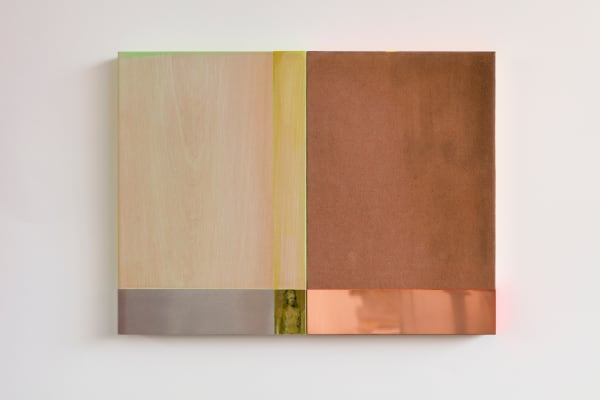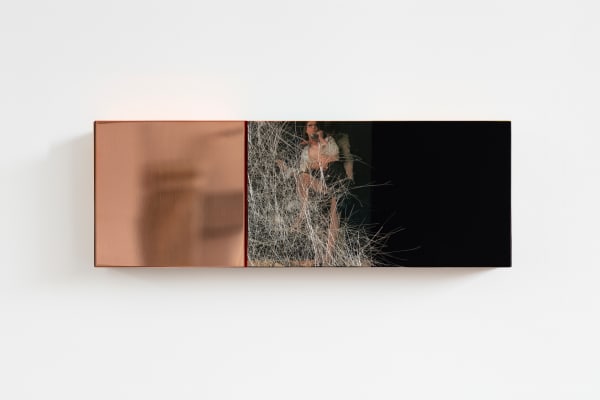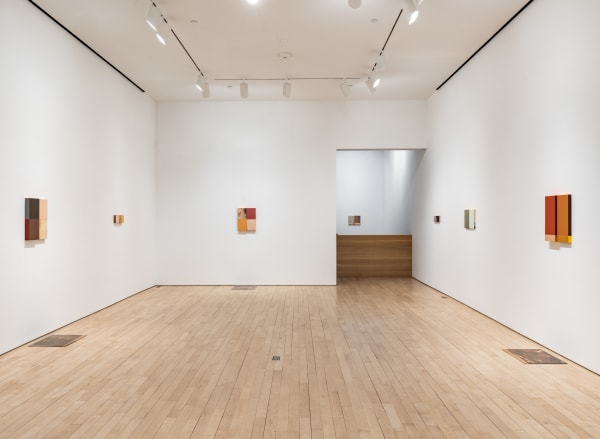Jane Bustin: Pirelli, let me count the ways [Part II]
Jane Lombard Gallery is pleased to present Jane Bustin’s Pirelli, let me count the ways [Part II], her third solo exhibition with the gallery. The London-based artist is recognized for her intimate and minimalist constructions, often exploring traditions of portraiture with hard-edge constructivist painting. Bustin chooses as her subject the ubiquitous pin-up girl, drawing from the Pirelli calendar, as well as vintage lenticular-based images. Also included is a text work featuring a poem by Elizabeth Barrett Browning, rearranged by Bustin, a ceramic bowl, and a video filmed in the Victorian-era poet’s home that weaves these narratives together, reframing the female gaze.
The Pirelli Calendar, which began in 1964, has long been a symbol of high fashion and art. Notably, the 1968 edition was inspired by twelve poems, with each photograph reflecting the essence of a different poet; one of which being Elizabeth Barrett Browning. In 1972, to align with the growing Women's Liberation Movement, Pirelli invited Sarah Moon as the first woman to photograph for the calendar. Moon, known for her romantic, feminine style, critically presented her models as nineteenth-century bordello girls photographed in the Villa des Tilleuls, the former headquarters of the Gestapo in occupied Paris. Bustin’s series is a direct, month-by-month response to these original images by Moon, which lie beneath her abstract paintings. The color palette of Bustin's work mirrors that of the original calendars with soft focus and silken fabrics, an additional element to subvert the viewer and challenge aesthetic associations linked to femininity.
In her mixed media paintings, Bustin applies natural pigment to porcelain, fabric, or wood, evoking the poetry of her subject matter into her material choices. Her abstract, geometric grids are rendered in soft, nuanced color palettes that feature reflective copper tones alongside rich hues. Each work embodies a month in the Pirelli calendar. Part two is exhibited here as July to December, in palettes evocative of the seasons – such as the white of snow or the orange of autumn leaves. Subtly concealed around the edges of the work are glimpses of fluorescent elements that radiate onto the surrounding walls, casting a luminous halo. This effect stands in stark contrast to the calendar photography below, perfectly embodying Bustin’s Modernist philosophy: “Instead of painting what I see, I paint what it feels like to see.”
Complementing the Pirelli series, Bustin’s lenticular works draw the viewer into an intimate, voyeuristic experience. She sources small, lenticular images of women, inviting the viewer to engage with them through an intriguing interplay of visibility and concealment as they suddenly appear nude or clothed upon movement. Additionally, in her text-based block print, Bustin re-writes and merges two poems by Elizabeth Barrett Browning, including the feminist Aurora Leigh, to create one poem – aptly typed in the Pirelli font. The resulting verse echoes the dichotomy between the passive nude women of the calendars and the active, often invisible, labor of women during that era. The phrase “let me count the ways,” which Bustin references in her title of the exhibition, is also the first line of Browning’s original sonnet. Conceptually linking herself, Sarah Moon and Elizabeth Barrett Browning, Bustin’s Pirelli, let me count the ways [Part II] is a resonant reflection of how women have been perceived throughout history and art history.
-
 Jane Bustin, While my hands tremble, 2023
Jane Bustin, While my hands tremble, 2023 -
 Jane Bustin, Suede Revolver, 2024
Jane Bustin, Suede Revolver, 2024 -
 Jane Bustin, July, 2025
Jane Bustin, July, 2025 -
 Jane Bustin, Brass, 2024
Jane Bustin, Brass, 2024 -
 Jane Bustin, August, 2025
Jane Bustin, August, 2025 -
 Jane Bustin, Ruffling Hair, 2025
Jane Bustin, Ruffling Hair, 2025 -
 Jane Bustin, September, 2025
Jane Bustin, September, 2025 -
 Jane Bustin, Personal Assistant, 2025
Jane Bustin, Personal Assistant, 2025 -
 Jane Bustin, October, 2024
Jane Bustin, October, 2024 -
 Jane Bustin, Nude Denim, 2024
Jane Bustin, Nude Denim, 2024 -
 Jane Bustin, November, 2024
Jane Bustin, November, 2024 -
 Jane Bustin, Rider, 2025
Jane Bustin, Rider, 2025 -
 Jane Bustin, December, 2024
Jane Bustin, December, 2024

















